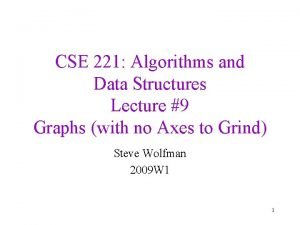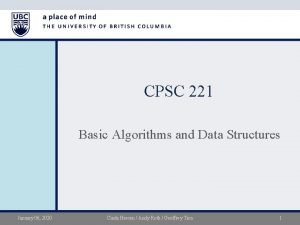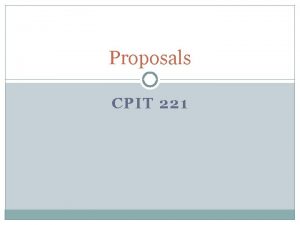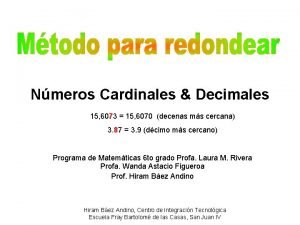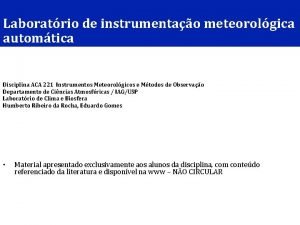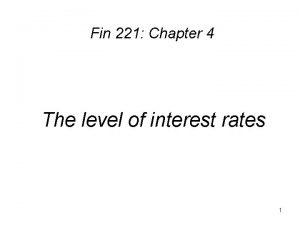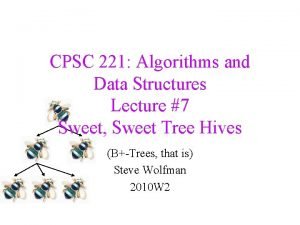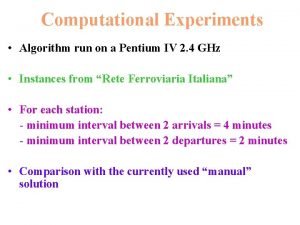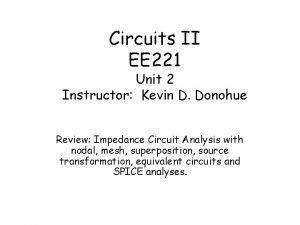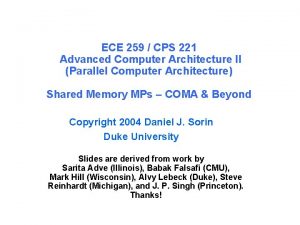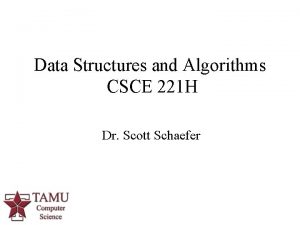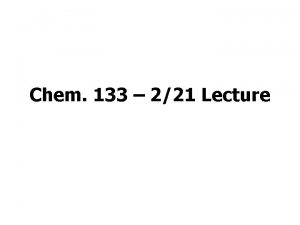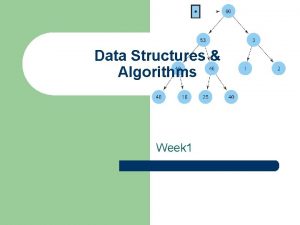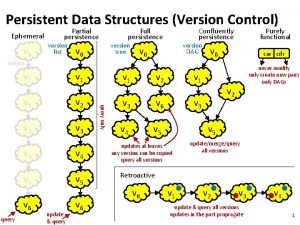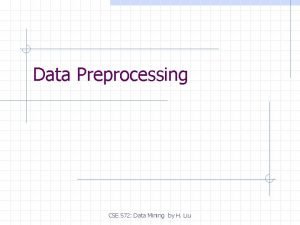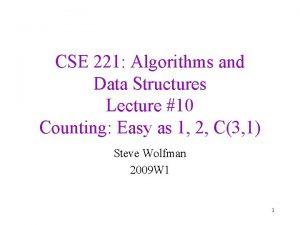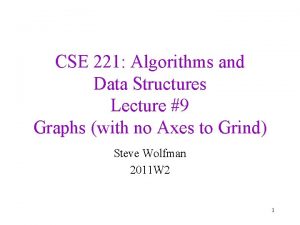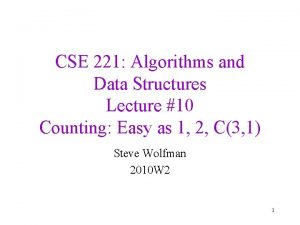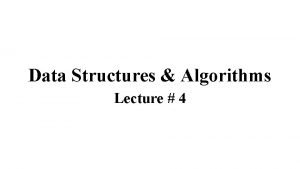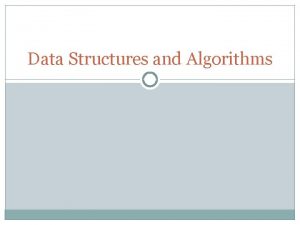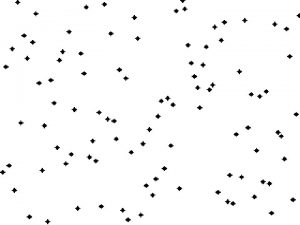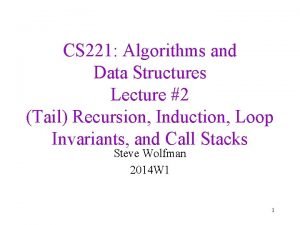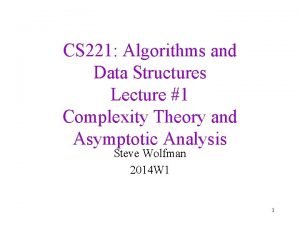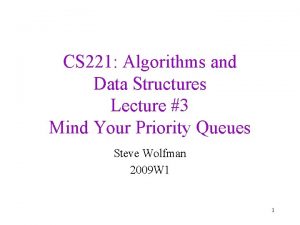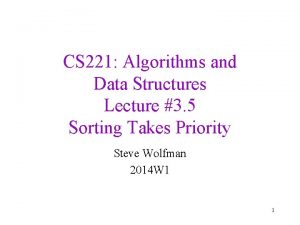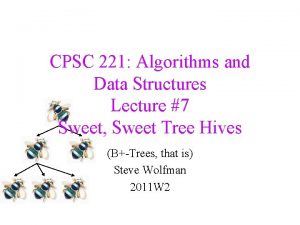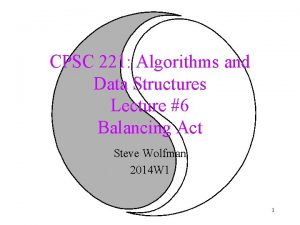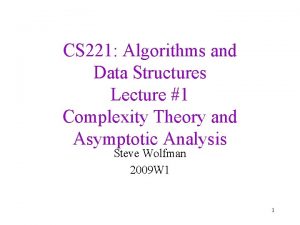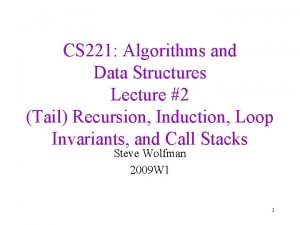CSE 221 Algorithms and Data Structures Lecture 8





![Hash Table Goal 0 “Vicki” We can do: We want to do: 1 a[2] Hash Table Goal 0 “Vicki” We can do: We want to do: 1 a[2]](https://slidetodoc.com/presentation_image_h2/c38be4a5b9af40c6b47712cfecce78ca/image-6.jpg)

























![Chaining Code Dictionary & find. Bucket(const Key & k) { return table[hash(k)%table. size]; } Chaining Code Dictionary & find. Bucket(const Key & k) { return table[hash(k)%table. size]; }](https://slidetodoc.com/presentation_image_h2/c38be4a5b9af40c6b47712cfecce78ca/image-32.jpg)






























- Slides: 62

CSE 221: Algorithms and Data Structures Lecture #8 What do you get when you put too many pigeons in one hole? Pigeon Hash Steve Wolfman 2009 W 1

Learning Goals After this unit, you should be able to: • Define various forms of the pigeonhole principle; recognize and solve the specific types of counting and hashing problems to which they apply. • Provide examples of the types of problems that can benefit from a hash data structure. • Compare and contrast open addressing and chaining. • Evaluate collision resolution policies. • Describe the conditions under which hashing can degenerate from O(1) expected complexity to O(n). • Identify the types of search problems that do not benefit from hashing (e. g. range searching) and explain why. • Manipulate data in hash structures both irrespective of implementation and also within a given implementation. 2

Today’s Outline • • • Constant-Time Dictionaries? Hash Table Outline Hash Functions Collisions and the Pigeonhole Principle Collision Resolution: – Chaining – Open-Addressing

Reminder: Dictionary ADT • • Dictionary operations – – – create destroy insert find delete – would be tastier with brownies insert • brownies - tasty midterm • prog-project – so painful… who invented templates? • find(wolf) • wolf - the perfect mix of oomph wolf – the perfect mix of oomph and Scrabble value • Stores values associated with user-specified keys – values may be any (homogenous) type – keys may be any (homogenous) comparable type

Implementations So Far insert find delete • Unsorted list • Trees O(1) O(log n) O(n) O(log n) • Special case: integer keys between 0 and k O(1) How about O(1) insert/find/delete for any key type?
![Hash Table Goal 0 Vicki We can do We want to do 1 a2 Hash Table Goal 0 “Vicki” We can do: We want to do: 1 a[2]](https://slidetodoc.com/presentation_image_h2/c38be4a5b9af40c6b47712cfecce78ca/image-6.jpg)
Hash Table Goal 0 “Vicki” We can do: We want to do: 1 a[2] = “Andrew” 2 “Dan” a[“Steve”] = “Andrew” Andrew “Steve” Andrew “Shervin” 3 “Ben” … … k-1 “Martin”

Today’s Outline • • • Constant-Time Dictionaries? Hash Table Outline Hash Functions Collisions and the Pigeonhole Principle Collision Resolution: – Chaining – Open-Addressing

Hash Table Approach Zasha Steve Nic f(x) Brad Ed But… is there a problem is this pipe-dream?

Hash Table Dictionary Data Structure • Hash function: maps keys to integers – result: can quickly find the right spot for a given entry • Unordered and sparse table – result: cannot efficiently list all entries, Zasha Steve Nic Brad Ed f(x)

Hash Table Terminology hash function Vicki Steve Dan f(x) Ben Martin keys in table load factor = # of entries table. Size collision

Hash Table Code First Pass Value & find(Key & key) { int index = hash(key) % table. Size; return Table[table. Size]; } What should the hash function be? What should the table size be? How should we resolve collisions?

Today’s Outline • • • Constant-Time Dictionaries? Hash Table Outline Hash Functions Collisions and the Pigeonhole Principle Collision Resolution: – Chaining – Open-Addressing

A Good Hash Function… …is easy (fast) to compute (O(1) and practically fast). …distributes the data evenly (hash(a) % size hash(b) % size). …uses the whole hash table (for all 0 k < size, there’s an i such that hash(i) % size = k).

Good Hash Function for Integers • Choose – table. Size is prime – hash(n) = n • Example: – table. Size = 7 0 1 2 3 insert(4) insert(17) find(12) insert(9) delete(17) 4 5 6

Good Hash Function for Strings? • Let s = s 1 s 2 s 3 s 4…s 5: choose – hash(s) = s 1 + s 2128 + s 31282 + s 41283 + … + sn 128 n Think of the string as a base 128 number. • Problems: – hash(“really, really big”) = well… something really, really big – hash(“one thing”) % 128 = hash(“other thing”) % 128

Making the String Hash Easy to Compute • Use Horner’s Rule int hash(String s) { h = 0; for (i = s. length() - 1; i >= 0; i--) { h = (si + 128*h) % table. Size; } return h; }

Making the String Hash Cause Few Conflicts • Ideas?

Hash Function Summary • Goals of a hash function – – reproducible mapping from key to table entry evenly distribute keys across the table separate commonly occurring keys (neighboring keys? ) complete quickly • Sample hash functions: – – – h(n) = n % size h(n) = string as base 128 number % size Multiplication hash: compute percentage through the table Universal hash function #1: dot product with random vector Universal hash function #2: next pseudo-random number

How to Design a Hash Function • Know what your keys are or • Study how your keys are distributed. • Try to include all important information in a key in the construction of its hash. • Try to make “neighboring” keys hash to very different places. • Prune the features used to create the hash until it runs “fast enough” (very application dependent).

Today’s Outline • • • Constant-Time Dictionaries? Hash Table Outline Hash Functions Collisions and the Pigeonhole Principle Collision Resolution: – Chaining – Open-Addressing

Collisions • Pigeonhole principle says we can’t avoid all collisions – try to hash without collision m keys into n slots with m > n – try to put 6 pigeons into 5 holes

The Pigeonhole Principle (informal) You can’t put k+1 pigeons into k holes without putting two pigeons in the same hole. This place just isn’t coo anymore. Image by en: User: Mc. Kay, used under CC attr/share-alike.

The Pigeonhole Principle (formal) Let X and Y be finite sets where |X| > |Y|. If f : X→Y, then f(x 1) = f(x 2) for some x 1, x 2 ∈ X, where x 1 ≠ x 2. f Now that’s coo! x 1 X Y x 2 f(x 1) = f(x 2)

The Pigeonhole Principle (Example #1) Suppose we have 5 colours of Halloween candy, and that there’s lots of candy in a bag. How many pieces of candy do we have to pull out of the bag if we want to be sure to get 2 of the same colour? a. 2 b. 4 c. 6 d. 8 e. None of these

The Pigeonhole Principle (Example #2) If there are 1000 pieces of each colour, how many do we need to pull to guarantee that we’ll get 2 black pieces of candy (assuming that black is one of the 5 colours)? a. 2 b. 4 c. 6 d. 8 e. None of these

The Pigeonhole Principle (Example #3) If 5 points are placed in a 6 cm x 8 cm rectangle, argue that there are two points that are not more than 5 cm apart. 8 cm Hint: How long is the diagonal? 6 cm

The Pigeonhole Principle (Example #4) For a, b ∈ Z, we write a divides b as a|b, meaning ∃ c ∈ Z such that b = ac. Consider n +1 distinct positive integers, each ≤ 2 n. Show that one of them must divide on of the others. For example, if n = 4, consider the following sets: {1, 2, 3, 7, 8} {2, 3, 4, 7, 8} {2, 3, 5, 7, 8} Hint: Any integer can be written as 2 k * q where k is an integer and q is odd. E. g. , 129 = 20 * 129; 60 = 22 * 15.

The Pigeonhole Principle (Full Glory) Let X and Y be finite sets with |X| = n, |Y| = m, and k = n/m. If f : X → Y, then ∃ k values x 1, x 2, …, xk ∈ X such that f(x 1) = f(x 2) = … f(xk). Informally: If n pigeons fly into m holes, at least 1 hole contains at least k = n/m pigeons. Proof: Assume there’s no such hole. Then, there at most ( n/m – 1)*m pigeons in all the holes, which is fewer than (n/m + 1 – 1)*m = n/m*m = n, but that is a contradiction. QED

Today’s Outline • • • Constant-Time Dictionaries? Hash Table Outline Hash Functions Collisions and the Pigeonhole Principle Collision Resolution: – Chaining – Open-Addressing

Collision Resolution • Pigeonhole principle says we can’t avoid all collisions – try to hash without collision m keys into n slots with m > n – try to put 6 pigeons into 5 holes • What do we do when two keys hash to the same entry? – chaining: put little dictionaries in each entry shove extra pigeons in one hole! – open addressing: pick a next entry to try

Hashing with Chaining • Put a little dictionary at each entry – choose type as appropriate – common case is unordered linked list (chain) • Properties – can be greater than 1 – performance degrades with length of chains h(a) = h(d) h(e) = h(b) 0 1 a d e b 2 3 4 5 6 c
![Chaining Code Dictionary find Bucketconst Key k return tablehashktable size Chaining Code Dictionary & find. Bucket(const Key & k) { return table[hash(k)%table. size]; }](https://slidetodoc.com/presentation_image_h2/c38be4a5b9af40c6b47712cfecce78ca/image-32.jpg)
Chaining Code Dictionary & find. Bucket(const Key & k) { return table[hash(k)%table. size]; } void insert(const Key & k, const Value & v) { find. Bucket(k). insert(k, v); } void delete(const Key & k) { find. Bucket(k). delete(k); } Value & find(const Key & k) { return find. Bucket(k). find(k); }

Load Factor in Chaining • Search cost – unsuccessful search: – successful search: • Desired load factor:

Today’s Outline • • • Constant-Time Dictionaries? Hash Table Outline Hash Functions Collisions and the Pigeonhole Principle Collision Resolution: – Chaining – Open-Addressing

Open Addressing What if we only allow one Key at each entry? – two objects that hash to the same spot can’t both go there – first one there gets the spot – next one must go in another spot • Properties – 1 – performance degrades with difficulty of finding right spot h(a) = h(d) h(e) = h(b) 0 1 2 3 4 5 6 a d e b c

Probing X-FILES • Probing how to: – – First probe - given a key k, hash to h(k) Second probe - if h(k) is occupied, try h(k) + f(1) Third probe - if h(k) + f(1) is occupied, try h(k) + f(2) And so forth • Probing properties – – the ith probe is to (h(k) + f(i)) mod size where f(0) = 0 if i reaches size, the insert has failed depending on f(), the insert may fail sooner long sequences of probes are costly!

Linear Probing f(i) = i • Probe sequence is – – h(k) mod size h(k) + 1 mod size h(k) + 2 mod size … • find. Entry using linear probing: bool find. Entry(const Key & k, Entry *& entry) { int probe. Point = hash 1(k); do { entry = &table[probe. Point]; probe. Point = (probe. Point + 1) % size; } while (!entry->is. Empty() && entry->key != k); return !entry->is. Empty(); }

Linear Probing Example insert(76) insert(93) insert(40) insert(47) insert(10) insert(55) 76%7 = 6 93%7 = 2 40%7 = 5 47%7 = 5 0 0 1 1 2 2 3 3 3 4 4 5 5 6 76 probes: 1 6 93 76 1 2 0 47 1 55%7 = 6 0 47 1 55 2 93 3 3 10 4 4 5 40 6 76 93 1 2 47 10%7 = 3 93 3 1 3

Load Factor in Linear Probing • For any < 1, linear probing will find an empty slot • Search cost (for large table sizes) – successful search: – unsuccessful search: Values hashed close to each other probe the same slots. • Linear probing suffers from primary clustering • Performance quickly degrades for > 1/2

Quadratic Probing f(i) = i 2 • Probe sequence is – – – h(k) mod size (h(k) + 1) mod size (h(k) + 4) mod size (h(k) + 9) mod size … • find. Entry using quadratic probing: bool find. Entry(const Key & k, Entry *& entry) { int probe. Point = hash 1(k), num. Probes = 0; do { entry = &table[probe. Point]; num. Probes++; probe. Point = (probe. Point + 2*num. Probes - 1) % size; } while (!entry->is. Empty() && entry->key != key); return !entry->is. Empty(); }

Quadratic Probing Example insert(76) insert(40) insert(48) insert(55) 76%7 = 6 40%7 = 5 48%7 = 6 5%7 = 5 55%7 = 6 0 0 0 1 1 2 2 3 3 3 4 4 5 5 6 6 76 probes: 1 48 0 47 1 2 5 3 3 55 4 40 5 40 76 6 76 1 2 5 3 3

Quadratic Probing Example insert(76) insert(93) insert(40) insert(35) insert(47) 76%7 = 6 93%7 = 2 40%7 = 5 35%7 = 0 47%7 = 5 0 0 1 1 2 2 3 3 3 4 4 4 5 5 5 40 6 76 probes: 1 6 93 76 1 2 93 1 2 35 0 35 1 93 1 2 93

Quadratic Probing Succeeds (for ½) • If size is prime and ½, then quadratic probing will find an empty slot in size/2 probes or fewer. – show for all 0 i, j size/2 and i j (h(x) + i 2) mod size (h(x) + j 2) mod size – by contradiction: suppose that for some i, j: (h(x) + i 2) mod size = (h(x) + j 2) mod size i 2 mod size = j 2 mod size (i 2 - j 2) mod size = 0 [(i + j)(i - j)] mod size = 0 – but how can i + j = 0 or i + j = size when i j and i, j size/2? – same for i - j mod size = 0

Quadratic Probing May Fail (for > ½) • For any i larger than size/2, there is some j smaller than i that adds with i to equal size (or a multiple of size). D’oh!

Load Factor in Quadratic Probing • For any ½, quadratic probing will find an empty slot; for greater , quadratic probing may find a slot • Quadratic probing does not suffer from primary clustering • Quadratic probing does suffer from secondary clustering – How could we possibly solve this? Values hashed to the SAME index probe the same slots.

Double Hashing f(i) = i hash 2(x) • Probe sequence is – – h 1(k) mod size (h 1(k) + 1 h 2(x)) mod size (h 1(k) + 2 h 2(x)) mod size … • Code for finding the next linear probe: bool find. Entry(const Key & k, Entry *& entry) { int probe. Point = hash 1(k), hash. Incr = hash 2(k); do { entry = &table[probe. Point]; probe. Point = (probe. Point + hash. Incr) % size; } while (!entry->is. Empty() && entry->key != k); return !entry->is. Empty(); }

A Good Double Hash Function… …is quick to evaluate. …differs from the original hash function. …never evaluates to 0 (mod size). One good choice is to choose a prime R < size and: hash 2(x) = R - (x mod R)

Double Hashing Example insert(76) insert(93) insert(40) insert(47) insert(10) insert(55) 76%7 = 6 93%7 = 2 40%7 = 5 47%7 = 5 10%7 = 3 55%7 = 6 5 - (47%5) = 3 5 - (55%5) = 5 0 0 1 1 47 2 2 2 93 3 3 10 4 4 4 55 5 40 5 40 6 76 6 76 probes: 1 6 93 76 1 2 93 1 0 2 0 1 2

Load Factor in Double Hashing • For any < 1, double hashing will find an empty slot (given appropriate table size and hash 2) • Search cost appears to approach optimal (random hash): – successful search: – unsuccessful search: • No primary clustering and no secondary clustering • One extra hash calculation

Deletion in Open Addressing delete(2) find(7) 0 0 1 1 2 2 2 3 7 3 4 4 5 5 6 6 Where is it? ! 7 • Must use lazy deletion! • On insertion, treat a deleted item as an empty slot

The Squished Pigeon Principle • An insert using open addressing cannot work with a load factor of 1 or more. • An insert using open addressing with quadratic probing may not work with a load factor of ½ or more. • Whether you use chaining or open addressing, large load factors lead to poor performance! • How can we relieve the pressure on the pigeons? Hint: think resizable arrays!

Rehashing • When the load factor gets “too large” (over a constant threshold on ), rehash all the elements into a new, larger table: – takes O(n), but amortized O(1) as long as we (just about) double table size on the resize – spreads keys back out, may drastically improve performance – gives us a chance to retune parameterized hash functions – avoids failure for open addressing techniques – allows arbitrarily large tables starting from a small table – clears out lazily deleted items

To Do • Start HW#3 (out soon) • Start Project 4 (out soon… our last project!) • Read Epp Section 7. 3 and Koffman & Wolfgang Chapter 9

Coming Up • Counting. What? Counting? ! Yes, counting, like: If you want to find the average depth of a binary tree as a function of its size, you have to count how many different binary trees there are with n nodes. Or: How many different ways are there to answer the question “How many fingers am I holding up, and which ones are they? ”

Extra Slides: Some Other Hashing Methods These are parameterized methods, which is handy if you know the keys in advance. In that case, you can randomly set the parameters a few times and pick a hash function that performs well. (Would that ever happen? How about when building a spell-check dictionary? )

Good Hashing: Multiplication Method • Hash function is defined by size plus a parameter A h. A(k) = size * (k*A mod 1) where 0 < A < 1 • Example: size = 10, A = 0. 485 h. A(50) = 10 * (50*0. 485 mod 1) = 10 * (24. 25 mod 1) = 10 * 0. 25 = 2 – no restriction on size! – if we’re building a static table, we can try several As – more computationally intensive than a single mod

Good Hashing: Universal Hash Function • Parameterized by prime size and vector: a = <a 0 a 1 … ar> where 0 <= ai < size • Represent each key as r + 1 integers where ki < size – size = 11, key = 39752 ==> <3, 9, 7, 5, 2> – size = 29, key = “hello world” ==> <8, 5, 12, 15, 23, 15, 18, 12, 4> ha(k) =

Universal Hash Function: Example • Context: hash strings of length 3 in a table of size 131 let a = <35, 100, 21> ha(“xyz”) = (35*120 + 100*121 + 21*122) % 131 = 129

Universal Hash Function • Strengths: – works on any type as long as you can form ki’s – if we’re building a static table, we can try many a’s – a random a has guaranteed good properties no matter what we’re hashing • Weaknesses – must choose prime table size larger than any ki

Alternate Universal Hash Function • Parameterized by k, a, and b: – k * size should fit into an int – a and b must be less than size Hk, a, b(x) =

Alternate Universe Hash Function: Example • Context: hash integers in a table of size 16 let k = 32, a = 100, b = 200 hk, a, b(1000) = ((100*1000 + 200) % (32*16)) / 32 = (100200 % 512) / 32 = 360 / 32 = 11

Universal Hash Function • Strengths: – if we’re building a static table, we can try many a’s – random a, b has guaranteed good properties no matter what we’re hashing – can choose any size table – very efficient if k and size are powers of 2 • Weaknesses – still need to turn non-integer keys into integers
 Ajit diwan
Ajit diwan Princeton data structures and algorithms
Princeton data structures and algorithms Data structures and algorithms tutorial
Data structures and algorithms tutorial Information retrieval data structures and algorithms
Information retrieval data structures and algorithms Data structures and algorithms bits pilani
Data structures and algorithms bits pilani Ajit diwan iitb
Ajit diwan iitb Data structures and algorithms
Data structures and algorithms Data structures and algorithms
Data structures and algorithms Ian munro waterloo
Ian munro waterloo Information retrieval data structures and algorithms
Information retrieval data structures and algorithms Data structures and algorithms
Data structures and algorithms Cse 221
Cse 221 Cse 221
Cse 221 Algorithms + data structures = programs
Algorithms + data structures = programs Analysis of algorithms lecture notes
Analysis of algorithms lecture notes Introduction to algorithms lecture notes
Introduction to algorithms lecture notes 01:640:244 lecture notes - lecture 15: plat, idah, farad
01:640:244 lecture notes - lecture 15: plat, idah, farad Examples of homologous
Examples of homologous Data stream
Data stream Csce 221 tamu syllabus
Csce 221 tamu syllabus Rotational statics
Rotational statics 866-221-0269
866-221-0269 Difference between arithmetic shift and logical shift
Difference between arithmetic shift and logical shift Sp 221
Sp 221 Emmett independent school district
Emmett independent school district Epsc 221
Epsc 221 Cinda heeren
Cinda heeren Csce 221
Csce 221 Cpit 221
Cpit 221 221 bce
221 bce Cpit221
Cpit221 Redondeo de números naturales
Redondeo de números naturales Aca 221
Aca 221 Fisher effect equation
Fisher effect equation Cs 221
Cs 221 Cpsc 221
Cpsc 221 Lagr 221
Lagr 221 Sebuah kapasitor
Sebuah kapasitor Aoi 221 gate
Aoi 221 gate Edu-221
Edu-221 Gs-221
Gs-221 Ee 221
Ee 221 Ancient chinese religion
Ancient chinese religion Gs-221
Gs-221 Bio 221
Bio 221 Einstein flow cytometry
Einstein flow cytometry 221 bc
221 bc If 221
If 221 866-221-0269
866-221-0269 Cps 221
Cps 221 Csce 221
Csce 221 Ee 221
Ee 221 133 221
133 221 Keyword macro parameters in system software
Keyword macro parameters in system software Assembler algorithm and data structures
Assembler algorithm and data structures Data structures and abstractions with java
Data structures and abstractions with java Adts, data structures, and problem solving with c++
Adts, data structures, and problem solving with c++ Data structures and algorithm
Data structures and algorithm Ephemeral data structure
Ephemeral data structure Data mining
Data mining Cse 572
Cse 572 Exploratory data analysis lecture notes
Exploratory data analysis lecture notes Bayesian classification in data mining lecture notes
Bayesian classification in data mining lecture notes











